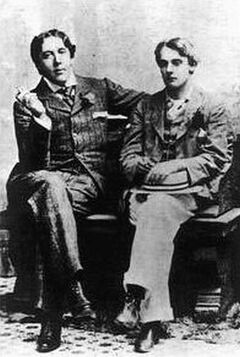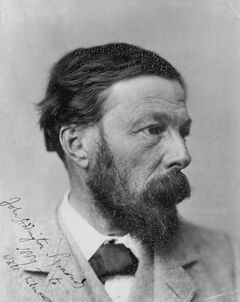
Oscar Wilde (1854-1900). Photo by Napoleon Sarony (1821-1896), 1882. Courtesy Wikimedia Commons.
The Uranians were a small and clandestine group of male poets who published works between 1858 (when William Johnson Cory published Ionica) and 1930. Although most of them were English, they had counterparts in the United States and France.
Origin of the term[]

Wilde (left) and Lord Alfred Douglas in 1893. Courtesy Wikimedia Commons.
Their name is commonly believed to derive from the work of the German theorist and campaigner Karl Heinrich Ulrichs in the 1860s, with the name later taken up by John Addington Symonds and others who rendered it as 'Uranian'. However, it has been argued that this derivation and coinage, at least for the English-speaking countries, is independent of Ulrichs's "coinage".
In his work Secreted Desires: The Major Uranians: Hopkins, Pater and Wilde, Michael M. Kaylor writes:
- Given that the prominent Uranians were trained classicists, I consider ludicrous the view, widely held, that ‘Uranian’ derives from the German apologias and legal appeals written by Karl-Heinrich Ulrichs in the 1860s, though his coinage Urning — employed to denote ‘a female psyche in a male body’ — does indeed derive from the same Classical sources, particularly the Symposium. Further, the Uranians did not consider themselves the possessors of a ‘female psyche’; the Uranians are not known, as a group, to have read works such as Forschungen über das Räthsel der mannmännlichen Liebe (Research on the Riddle of Male-Male Love); the Uranians were opposed to Ulrichs’s claims for androphilic, homoerotic liberation at the expense of the paederastic; and, even when a connection was drawn to such Germanic ideas and terminology, it appeared long after the term ‘Uranian’ had become commonplace within Uranian circles, hence was not a ‘borrowing from’ but a ‘bridge to’ the like-minded across the Channel by apologists such as Symonds.[1]
The movement[]

William Johnson Cory (1823-1892), from Ionicus by Lord Escher. Courtesy Wikimedia Commons.

John Addington Symonds, picture for Walt Whitman, dated 1889. Courtesy Wikimedia Commons.
The work of the Uranian poets was characterized by an idealised appeal to the history of Ancient Greece and a sentimental infatuation of older men for adolescent boys, as well as by a use of conservative verse forms.
The chief poets of this clique were William Johnson Cory, Lord Alfred Douglas, Montague Summers, John Francis Bloxam, Charles Kains Jackson, John Gambril Nicholson, Rev. E.E. Bradford, John Addington Symonds, Edmund John, John Moray Stuart-Young, Charles Edward Sayle, Fabian S. Woodley, and several pseudonymous authors such as "Philebus" (John Leslie Barford) and "A. Newman" (Francis Edwin Murray). The flamboyantly eccentric novelist Frederick Rolfe (also known as "Baron Corvo") was a unifying presence in their social network, both within and without Venice.
The fame of their work was limited by late Victorian and Edwardian taboos, by the extremely small editions (often privately printed) in which their verse was promulgated, and by the generally saccharine and occasionally misogynistic nature of their poetry. However, historian Neil McKenna has argued that Uranian poetry had a central role in the upper-class homosexual subcultures of the Victorian period. He insisted that poetry was the main medium through which writers such as Oscar Wilde, George Ives, and Rennell Rodd sought to challenge the anti-homosexual prejudices of the age.
Marginally associated with their world were more famous writers such as Edward Carpenter, as well as the obscure but prophetic poet-printer Ralph Chubb. His majestic volumes of lithographs celebrated the adolescent boy as an Ideal. The Uranian quest to revive the Greek notion of paiderastia was not successful because of the conservative Victorian mores of the day.
There are only 2 book-length studies of the Uranians: Love In Earnest by Timothy d'Arch Smith (1970)[1] and Secreted Desires: The Major Uranians: Hopkins, Pater and Wilde by Michael Matthew Kaylor (2006; available as an open-access E-text) [2]. Kaylor expands the Uranian canon by situating several major Victorians within the group. Other critics, such as Richard Dellamora (Masculine Desire: The Sexual Politics of Victorian Aestheticism, 1990 [3]) and Linda Dowling (Hellenism and Homosexuality in Victorian Oxford, 1994 [4]) have contributed more recently to the scant knowledge about this group. Paul Fussell discusses Uranian poetry in his book The Great War and Modern Memory (1975), suggesting that it provided a model for homoerotic representations in the war poets of World War I (e.g. Wilfred Owen).
See also[]
References[]
- Timothy d'Arch Smith, Love in Earnest: Some Notes on the Lives and Writings of English "Uranian" Poets from 1889 to 1930 (1970).
- Michael Matthew Kaylor, Secreted Desires: The Major Uranians: Hopkins, Pater and Wilde (2006)
- Neil McKenna, The Secret Life of Oscar Wilde (2003).
Notes[]
- ↑ Kaylor,p. xiii, footnote
External links[]
- Michael Matthew Kaylor, Secreted Desires: The Major Uranians: Hopkins, Pater and Wilde (2006), a 500-page scholarly volume that considers the prominent Victorian writers of Uranian poetry and prose, such as Johnson (the author has made this volume available in a free, open-access, PDF version).
- History of The Literature Homoerotic
| This page uses Creative Commons Licensed content from Wikipedia. (view article). (view authors). |
| This page uses content from Wikinfo . The original article was at Wikinfo:Uranian poetry. The list of authors can be seen in the (view authors). page history. The text of this Wikinfo article is available under the GNU Free Documentation License and the Creative Commons Attribution-Share Alike 3.0 license. |